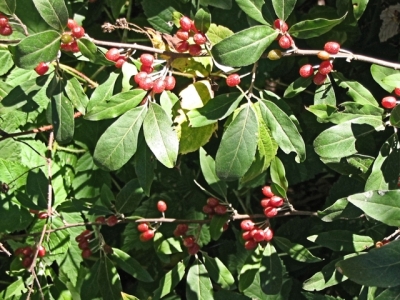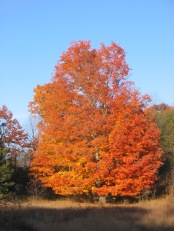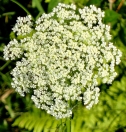July through August

This photo shows Canadian anemone still blooming July 3rd (2019) amid Onoclea sensibilis or sensitive fern (the light green leaves). This fern is native to most of the eastern United States.

Eutrochium purpureum or Joe Pye weed. It likes damp areas and periodic shade through the day. The dull pink flowers have a slight vanilla scent. See how the leaves tend to whorl around the stem? That’s why it is the Eutrochium (well wheeled) genius. According to Edible Wild Food, all parts are edible. The link will tell you more.

Saponaria officinalis, Bouncing Bet, introduced for its use. According to The Herb Garden blog: “It contains saponins, which cause boiled solutions made with soapwort to lather up. It’s like nature’s little bar of soap.” [family Caryophyllacea (pink family), order Caryophyallales, subclass Caryophyllidae, class Magnoliopsida]

Hypericum perforatum, Common St. Johnswort, introduced for its healing properties. [family Clusiaceae, order Theales, subclass Dilleniidoe, Class Magnoliopsida]

Convolvulus sepium, or Calystegia sepium, Hedge Bindweed (Morning-Glory family). The plant is capable of climbing to 10′ and it can poison the soil to prevent other plants’ competition. [family Convolvulaceae, order Solanales, subclass Asteridae, class Magnoliopsida]

Daucus carota, Wild Carrot, or the ubiquitous Queen Anne’s Lace, an introduced species. While this plant is edible, foragers should be careful not to confuse it with Conium maculatum, or poison hemlock, from the same plant family. Hemlock was the poison given Socrates. The two plants look similar. [family Apiaceae or Umbelliferae (carrot), order Apiales, subclass Rosidae, class Magnoliopsida]

Rudbeckia lancinata, Green-headed Coneflower, a native plant. [family Asteraceae, order Asterales, subclass Asteridae, class Magnoliopsida]

Mondarda fistulosa, Wild Bergamot, a native wetland plant whose cultivars are widely used in horticulture industry. [family Laminaceae, order Lamiales, subclass Asteridae, Class Magnoliopsida]
I wrote about Monarda or Bee Balm in this post.

Mondarda punctata, Horsemint, another native, but capable of growing in dry waste areas. [family Laminaceae, order Lamiales, subclass Asteridae, Class Magnoliopsida]

Asclepias tuberosa, Butterfly-weed, widely sold as a landscape plant but it is also very important to the survival of Monarch butterfly larvae.[family Asclepiadaceae, order Gentianales, subclass Asteridae, class Magnoliopsida]

Solidago altissima, Canada Goldenrod [family Asteraceae, order Asterales, subclass Asteridae, class Magnoliopsida]

Bidens laevis, Bur-marigold, [family Asteraceae, order Asterales, subclass Asteridae, class Magnoliopsida]

Asclepias syriaca, Common milkweed. Recent conservation post urge these plants be left to support Monarch Butterfly larvae. [family Asclepiadaceae, order Gentianales, subclass Asteridae, class Magnoliopsida]

Andropogon gerardii, Big Bluestem, [family Poaceae or gramineae, order Cyperales, subclass Commelinidae, class Liliopsiada]

Shizachyrium scoparium, Little Bluestem [family Poaceae or gramineae, order Cyperales, subclass Commelinidae, class Liliopsiada]

Rudbeckia hirta, Black-eyed Susan, [family Asteraceae, order Asterales, subclass Asteridae, class Magnoliopsida]

Invasive autumn olive, Elaeagnus umbellata [family Elaegnaceae, order Rhamnales, subclass Rosida, class Magnoliopsida]



































Leave a comment
Comments feed for this article